Teaching, Learning, and Assessment in Teaching and Training
VerifiedAdded on 2023/06/03
|13
|5563
|396
AI Summary
This article discusses the roles and responsibilities of teachers, including creating a safe learning environment, assessing learning styles, designing lesson plans, and assessing student progress. It also covers the importance of initial assessment, promoting equality and diversity in the classroom, and legislation related to equality and diversity.
Contribute Materials
Your contribution can guide someone’s learning journey. Share your
documents today.
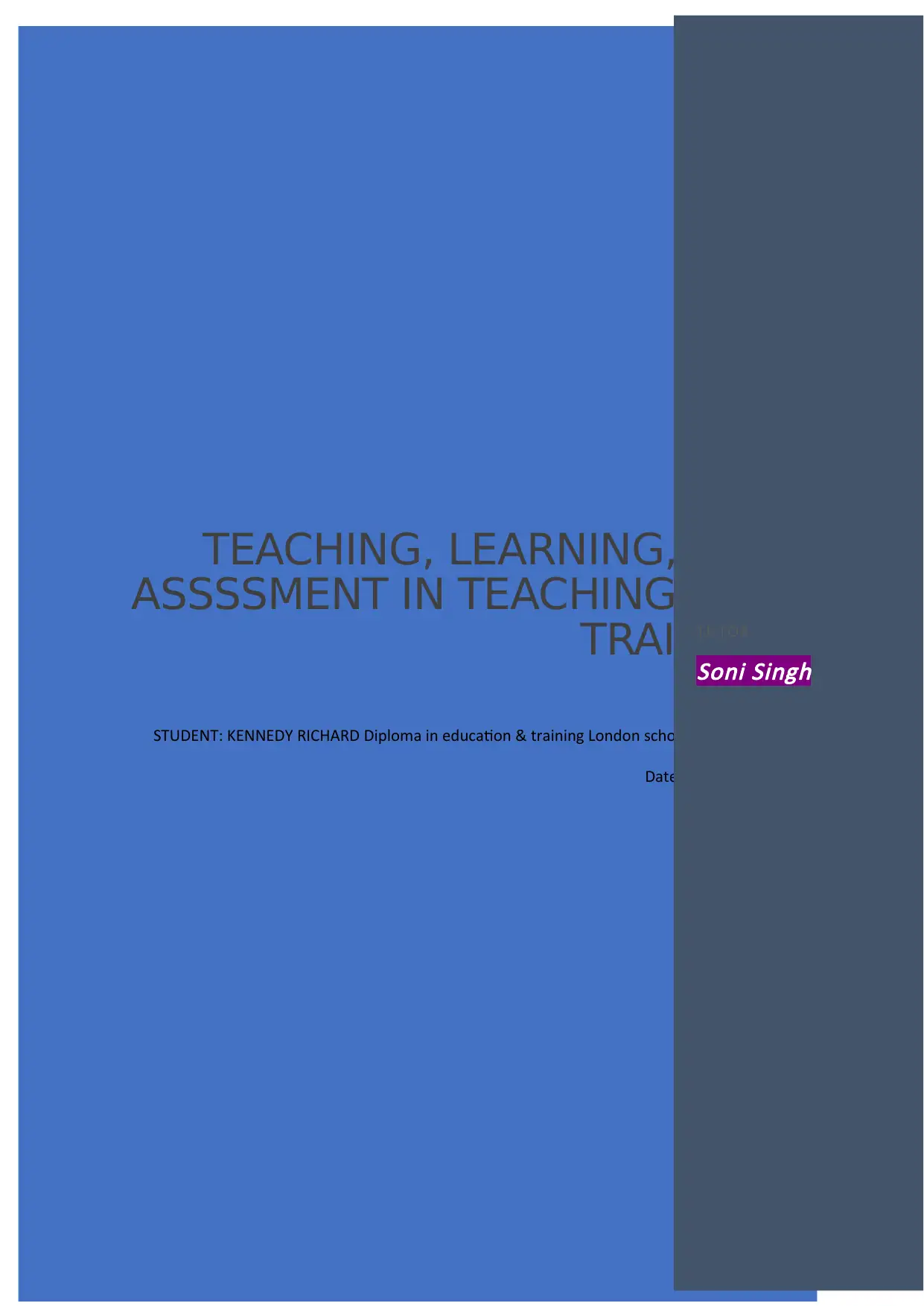
TEACHING, LEARNING, AND
ASSSSMENT IN TEACHING AND
TRAINING
STUDENT: KENNEDY RICHARD Diploma in education & training London school of academics
Date : 5th Nov.2018
TUTOR:
Soni Singh
ASSSSMENT IN TEACHING AND
TRAINING
STUDENT: KENNEDY RICHARD Diploma in education & training London school of academics
Date : 5th Nov.2018
TUTOR:
Soni Singh
Secure Best Marks with AI Grader
Need help grading? Try our AI Grader for instant feedback on your assignments.
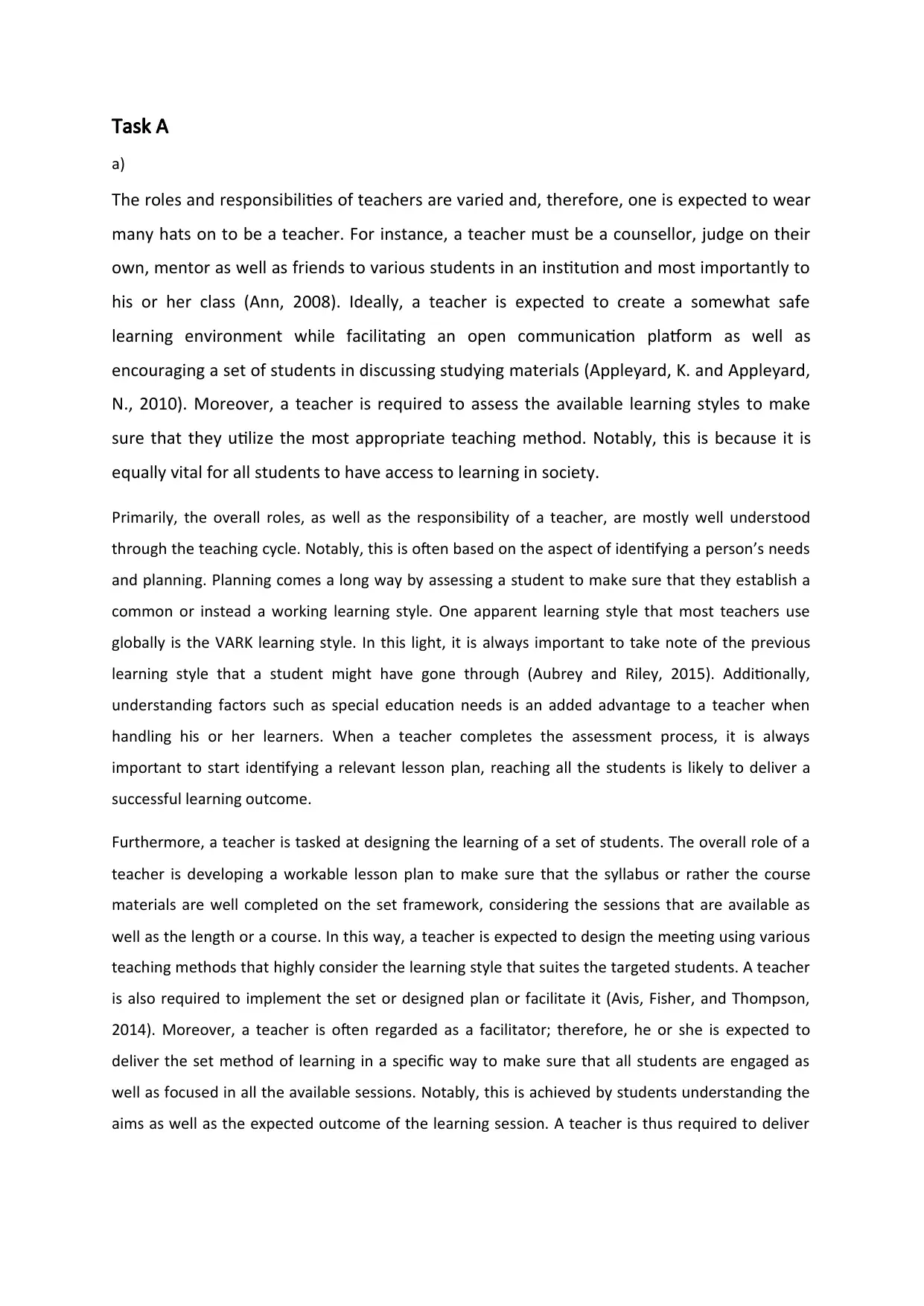
Task A
a)
The roles and responsibilities of teachers are varied and, therefore, one is expected to wear
many hats on to be a teacher. For instance, a teacher must be a counsellor, judge on their
own, mentor as well as friends to various students in an institution and most importantly to
his or her class (Ann, 2008). Ideally, a teacher is expected to create a somewhat safe
learning environment while facilitating an open communication platform as well as
encouraging a set of students in discussing studying materials (Appleyard, K. and Appleyard,
N., 2010). Moreover, a teacher is required to assess the available learning styles to make
sure that they utilize the most appropriate teaching method. Notably, this is because it is
equally vital for all students to have access to learning in society.
Primarily, the overall roles, as well as the responsibility of a teacher, are mostly well understood
through the teaching cycle. Notably, this is often based on the aspect of identifying a person’s needs
and planning. Planning comes a long way by assessing a student to make sure that they establish a
common or instead a working learning style. One apparent learning style that most teachers use
globally is the VARK learning style. In this light, it is always important to take note of the previous
learning style that a student might have gone through (Aubrey and Riley, 2015). Additionally,
understanding factors such as special education needs is an added advantage to a teacher when
handling his or her learners. When a teacher completes the assessment process, it is always
important to start identifying a relevant lesson plan, reaching all the students is likely to deliver a
successful learning outcome.
Furthermore, a teacher is tasked at designing the learning of a set of students. The overall role of a
teacher is developing a workable lesson plan to make sure that the syllabus or rather the course
materials are well completed on the set framework, considering the sessions that are available as
well as the length or a course. In this way, a teacher is expected to design the meeting using various
teaching methods that highly consider the learning style that suites the targeted students. A teacher
is also required to implement the set or designed plan or facilitate it (Avis, Fisher, and Thompson,
2014). Moreover, a teacher is often regarded as a facilitator; therefore, he or she is expected to
deliver the set method of learning in a specific way to make sure that all students are engaged as
well as focused in all the available sessions. Notably, this is achieved by students understanding the
aims as well as the expected outcome of the learning session. A teacher is thus required to deliver
a)
The roles and responsibilities of teachers are varied and, therefore, one is expected to wear
many hats on to be a teacher. For instance, a teacher must be a counsellor, judge on their
own, mentor as well as friends to various students in an institution and most importantly to
his or her class (Ann, 2008). Ideally, a teacher is expected to create a somewhat safe
learning environment while facilitating an open communication platform as well as
encouraging a set of students in discussing studying materials (Appleyard, K. and Appleyard,
N., 2010). Moreover, a teacher is required to assess the available learning styles to make
sure that they utilize the most appropriate teaching method. Notably, this is because it is
equally vital for all students to have access to learning in society.
Primarily, the overall roles, as well as the responsibility of a teacher, are mostly well understood
through the teaching cycle. Notably, this is often based on the aspect of identifying a person’s needs
and planning. Planning comes a long way by assessing a student to make sure that they establish a
common or instead a working learning style. One apparent learning style that most teachers use
globally is the VARK learning style. In this light, it is always important to take note of the previous
learning style that a student might have gone through (Aubrey and Riley, 2015). Additionally,
understanding factors such as special education needs is an added advantage to a teacher when
handling his or her learners. When a teacher completes the assessment process, it is always
important to start identifying a relevant lesson plan, reaching all the students is likely to deliver a
successful learning outcome.
Furthermore, a teacher is tasked at designing the learning of a set of students. The overall role of a
teacher is developing a workable lesson plan to make sure that the syllabus or rather the course
materials are well completed on the set framework, considering the sessions that are available as
well as the length or a course. In this way, a teacher is expected to design the meeting using various
teaching methods that highly consider the learning style that suites the targeted students. A teacher
is also required to implement the set or designed plan or facilitate it (Avis, Fisher, and Thompson,
2014). Moreover, a teacher is often regarded as a facilitator; therefore, he or she is expected to
deliver the set method of learning in a specific way to make sure that all students are engaged as
well as focused in all the available sessions. Notably, this is achieved by students understanding the
aims as well as the expected outcome of the learning session. A teacher is thus required to deliver
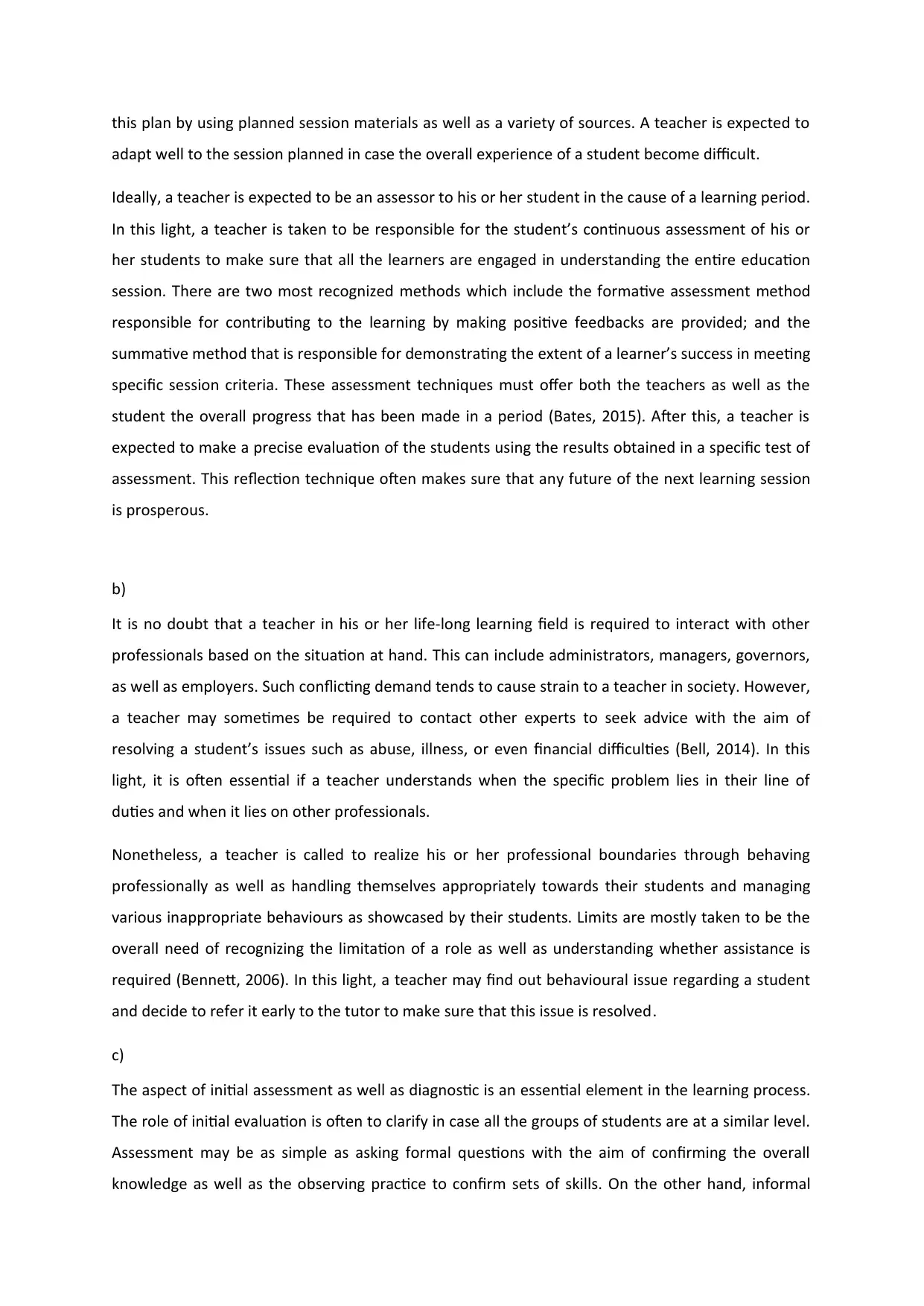
this plan by using planned session materials as well as a variety of sources. A teacher is expected to
adapt well to the session planned in case the overall experience of a student become difficult.
Ideally, a teacher is expected to be an assessor to his or her student in the cause of a learning period.
In this light, a teacher is taken to be responsible for the student’s continuous assessment of his or
her students to make sure that all the learners are engaged in understanding the entire education
session. There are two most recognized methods which include the formative assessment method
responsible for contributing to the learning by making positive feedbacks are provided; and the
summative method that is responsible for demonstrating the extent of a learner’s success in meeting
specific session criteria. These assessment techniques must offer both the teachers as well as the
student the overall progress that has been made in a period (Bates, 2015). After this, a teacher is
expected to make a precise evaluation of the students using the results obtained in a specific test of
assessment. This reflection technique often makes sure that any future of the next learning session
is prosperous.
b)
It is no doubt that a teacher in his or her life-long learning field is required to interact with other
professionals based on the situation at hand. This can include administrators, managers, governors,
as well as employers. Such conflicting demand tends to cause strain to a teacher in society. However,
a teacher may sometimes be required to contact other experts to seek advice with the aim of
resolving a student’s issues such as abuse, illness, or even financial difficulties (Bell, 2014). In this
light, it is often essential if a teacher understands when the specific problem lies in their line of
duties and when it lies on other professionals.
Nonetheless, a teacher is called to realize his or her professional boundaries through behaving
professionally as well as handling themselves appropriately towards their students and managing
various inappropriate behaviours as showcased by their students. Limits are mostly taken to be the
overall need of recognizing the limitation of a role as well as understanding whether assistance is
required (Bennett, 2006). In this light, a teacher may find out behavioural issue regarding a student
and decide to refer it early to the tutor to make sure that this issue is resolved.
c)
The aspect of initial assessment as well as diagnostic is an essential element in the learning process.
The role of initial evaluation is often to clarify in case all the groups of students are at a similar level.
Assessment may be as simple as asking formal questions with the aim of confirming the overall
knowledge as well as the observing practice to confirm sets of skills. On the other hand, informal
adapt well to the session planned in case the overall experience of a student become difficult.
Ideally, a teacher is expected to be an assessor to his or her student in the cause of a learning period.
In this light, a teacher is taken to be responsible for the student’s continuous assessment of his or
her students to make sure that all the learners are engaged in understanding the entire education
session. There are two most recognized methods which include the formative assessment method
responsible for contributing to the learning by making positive feedbacks are provided; and the
summative method that is responsible for demonstrating the extent of a learner’s success in meeting
specific session criteria. These assessment techniques must offer both the teachers as well as the
student the overall progress that has been made in a period (Bates, 2015). After this, a teacher is
expected to make a precise evaluation of the students using the results obtained in a specific test of
assessment. This reflection technique often makes sure that any future of the next learning session
is prosperous.
b)
It is no doubt that a teacher in his or her life-long learning field is required to interact with other
professionals based on the situation at hand. This can include administrators, managers, governors,
as well as employers. Such conflicting demand tends to cause strain to a teacher in society. However,
a teacher may sometimes be required to contact other experts to seek advice with the aim of
resolving a student’s issues such as abuse, illness, or even financial difficulties (Bell, 2014). In this
light, it is often essential if a teacher understands when the specific problem lies in their line of
duties and when it lies on other professionals.
Nonetheless, a teacher is called to realize his or her professional boundaries through behaving
professionally as well as handling themselves appropriately towards their students and managing
various inappropriate behaviours as showcased by their students. Limits are mostly taken to be the
overall need of recognizing the limitation of a role as well as understanding whether assistance is
required (Bennett, 2006). In this light, a teacher may find out behavioural issue regarding a student
and decide to refer it early to the tutor to make sure that this issue is resolved.
c)
The aspect of initial assessment as well as diagnostic is an essential element in the learning process.
The role of initial evaluation is often to clarify in case all the groups of students are at a similar level.
Assessment may be as simple as asking formal questions with the aim of confirming the overall
knowledge as well as the observing practice to confirm sets of skills. On the other hand, informal
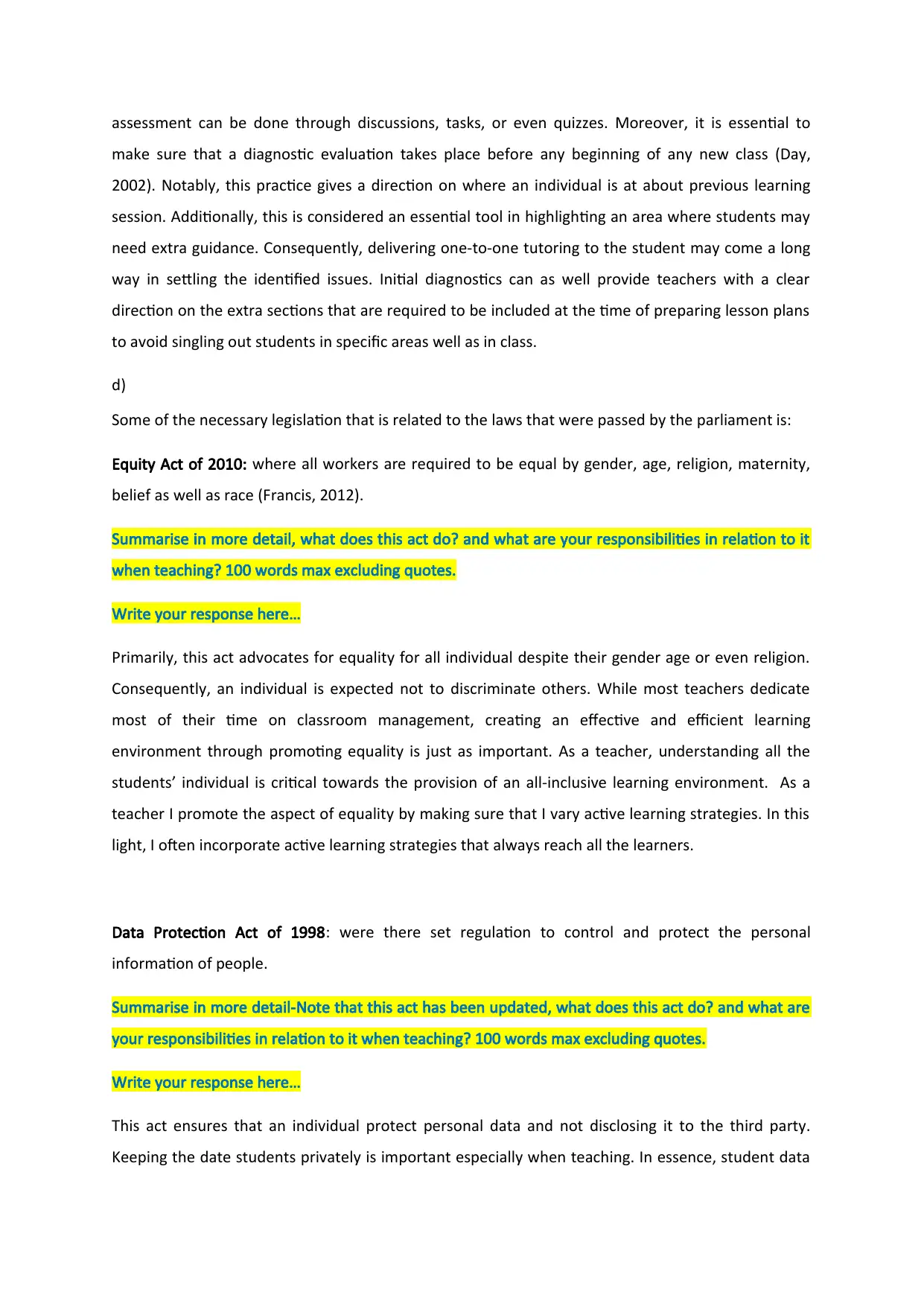
assessment can be done through discussions, tasks, or even quizzes. Moreover, it is essential to
make sure that a diagnostic evaluation takes place before any beginning of any new class (Day,
2002). Notably, this practice gives a direction on where an individual is at about previous learning
session. Additionally, this is considered an essential tool in highlighting an area where students may
need extra guidance. Consequently, delivering one-to-one tutoring to the student may come a long
way in settling the identified issues. Initial diagnostics can as well provide teachers with a clear
direction on the extra sections that are required to be included at the time of preparing lesson plans
to avoid singling out students in specific areas well as in class.
d)
Some of the necessary legislation that is related to the laws that were passed by the parliament is:
Equity Act of 2010: where all workers are required to be equal by gender, age, religion, maternity,
belief as well as race (Francis, 2012).
Summarise in more detail, what does this act do? and what are your responsibilities in relation to it
when teaching? 100 words max excluding quotes.
Write your response here…
Primarily, this act advocates for equality for all individual despite their gender age or even religion.
Consequently, an individual is expected not to discriminate others. While most teachers dedicate
most of their time on classroom management, creating an effective and efficient learning
environment through promoting equality is just as important. As a teacher, understanding all the
students’ individual is critical towards the provision of an all-inclusive learning environment. As a
teacher I promote the aspect of equality by making sure that I vary active learning strategies. In this
light, I often incorporate active learning strategies that always reach all the learners.
Data Protection Act of 1998: were there set regulation to control and protect the personal
information of people.
Summarise in more detail-Note that this act has been updated, what does this act do? and what are
your responsibilities in relation to it when teaching? 100 words max excluding quotes.
Write your response here…
This act ensures that an individual protect personal data and not disclosing it to the third party.
Keeping the date students privately is important especially when teaching. In essence, student data
make sure that a diagnostic evaluation takes place before any beginning of any new class (Day,
2002). Notably, this practice gives a direction on where an individual is at about previous learning
session. Additionally, this is considered an essential tool in highlighting an area where students may
need extra guidance. Consequently, delivering one-to-one tutoring to the student may come a long
way in settling the identified issues. Initial diagnostics can as well provide teachers with a clear
direction on the extra sections that are required to be included at the time of preparing lesson plans
to avoid singling out students in specific areas well as in class.
d)
Some of the necessary legislation that is related to the laws that were passed by the parliament is:
Equity Act of 2010: where all workers are required to be equal by gender, age, religion, maternity,
belief as well as race (Francis, 2012).
Summarise in more detail, what does this act do? and what are your responsibilities in relation to it
when teaching? 100 words max excluding quotes.
Write your response here…
Primarily, this act advocates for equality for all individual despite their gender age or even religion.
Consequently, an individual is expected not to discriminate others. While most teachers dedicate
most of their time on classroom management, creating an effective and efficient learning
environment through promoting equality is just as important. As a teacher, understanding all the
students’ individual is critical towards the provision of an all-inclusive learning environment. As a
teacher I promote the aspect of equality by making sure that I vary active learning strategies. In this
light, I often incorporate active learning strategies that always reach all the learners.
Data Protection Act of 1998: were there set regulation to control and protect the personal
information of people.
Summarise in more detail-Note that this act has been updated, what does this act do? and what are
your responsibilities in relation to it when teaching? 100 words max excluding quotes.
Write your response here…
This act ensures that an individual protect personal data and not disclosing it to the third party.
Keeping the date students privately is important especially when teaching. In essence, student data
Secure Best Marks with AI Grader
Need help grading? Try our AI Grader for instant feedback on your assignments.
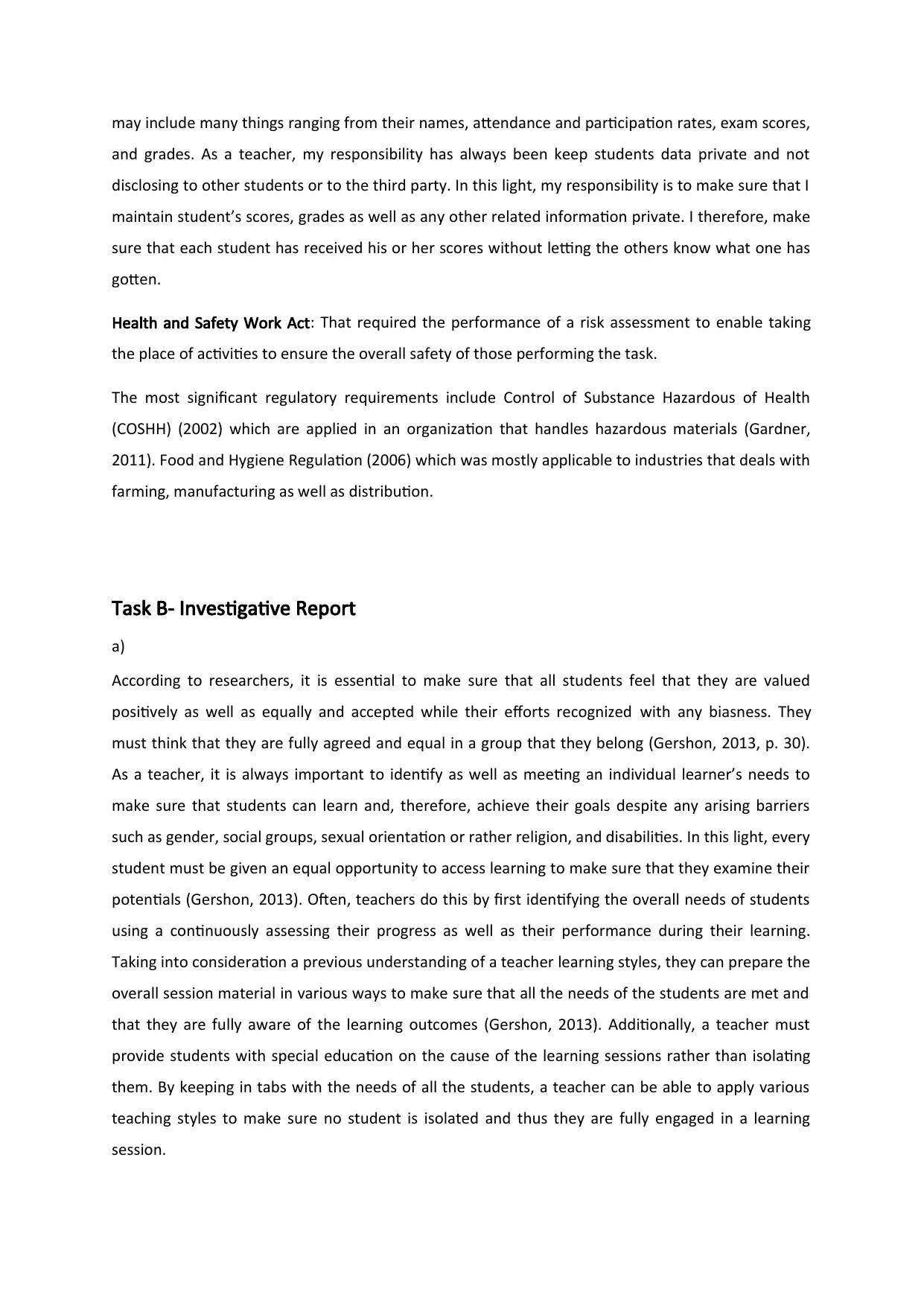
may include many things ranging from their names, attendance and participation rates, exam scores,
and grades. As a teacher, my responsibility has always been keep students data private and not
disclosing to other students or to the third party. In this light, my responsibility is to make sure that I
maintain student’s scores, grades as well as any other related information private. I therefore, make
sure that each student has received his or her scores without letting the others know what one has
gotten.
Health and Safety Work Act: That required the performance of a risk assessment to enable taking
the place of activities to ensure the overall safety of those performing the task.
The most significant regulatory requirements include Control of Substance Hazardous of Health
(COSHH) (2002) which are applied in an organization that handles hazardous materials (Gardner,
2011). Food and Hygiene Regulation (2006) which was mostly applicable to industries that deals with
farming, manufacturing as well as distribution.
Task B- Investigative Report
a)
According to researchers, it is essential to make sure that all students feel that they are valued
positively as well as equally and accepted while their efforts recognized with any biasness. They
must think that they are fully agreed and equal in a group that they belong (Gershon, 2013, p. 30).
As a teacher, it is always important to identify as well as meeting an individual learner’s needs to
make sure that students can learn and, therefore, achieve their goals despite any arising barriers
such as gender, social groups, sexual orientation or rather religion, and disabilities. In this light, every
student must be given an equal opportunity to access learning to make sure that they examine their
potentials (Gershon, 2013). Often, teachers do this by first identifying the overall needs of students
using a continuously assessing their progress as well as their performance during their learning.
Taking into consideration a previous understanding of a teacher learning styles, they can prepare the
overall session material in various ways to make sure that all the needs of the students are met and
that they are fully aware of the learning outcomes (Gershon, 2013). Additionally, a teacher must
provide students with special education on the cause of the learning sessions rather than isolating
them. By keeping in tabs with the needs of all the students, a teacher can be able to apply various
teaching styles to make sure no student is isolated and thus they are fully engaged in a learning
session.
and grades. As a teacher, my responsibility has always been keep students data private and not
disclosing to other students or to the third party. In this light, my responsibility is to make sure that I
maintain student’s scores, grades as well as any other related information private. I therefore, make
sure that each student has received his or her scores without letting the others know what one has
gotten.
Health and Safety Work Act: That required the performance of a risk assessment to enable taking
the place of activities to ensure the overall safety of those performing the task.
The most significant regulatory requirements include Control of Substance Hazardous of Health
(COSHH) (2002) which are applied in an organization that handles hazardous materials (Gardner,
2011). Food and Hygiene Regulation (2006) which was mostly applicable to industries that deals with
farming, manufacturing as well as distribution.
Task B- Investigative Report
a)
According to researchers, it is essential to make sure that all students feel that they are valued
positively as well as equally and accepted while their efforts recognized with any biasness. They
must think that they are fully agreed and equal in a group that they belong (Gershon, 2013, p. 30).
As a teacher, it is always important to identify as well as meeting an individual learner’s needs to
make sure that students can learn and, therefore, achieve their goals despite any arising barriers
such as gender, social groups, sexual orientation or rather religion, and disabilities. In this light, every
student must be given an equal opportunity to access learning to make sure that they examine their
potentials (Gershon, 2013). Often, teachers do this by first identifying the overall needs of students
using a continuously assessing their progress as well as their performance during their learning.
Taking into consideration a previous understanding of a teacher learning styles, they can prepare the
overall session material in various ways to make sure that all the needs of the students are met and
that they are fully aware of the learning outcomes (Gershon, 2013). Additionally, a teacher must
provide students with special education on the cause of the learning sessions rather than isolating
them. By keeping in tabs with the needs of all the students, a teacher can be able to apply various
teaching styles to make sure no student is isolated and thus they are fully engaged in a learning
session.
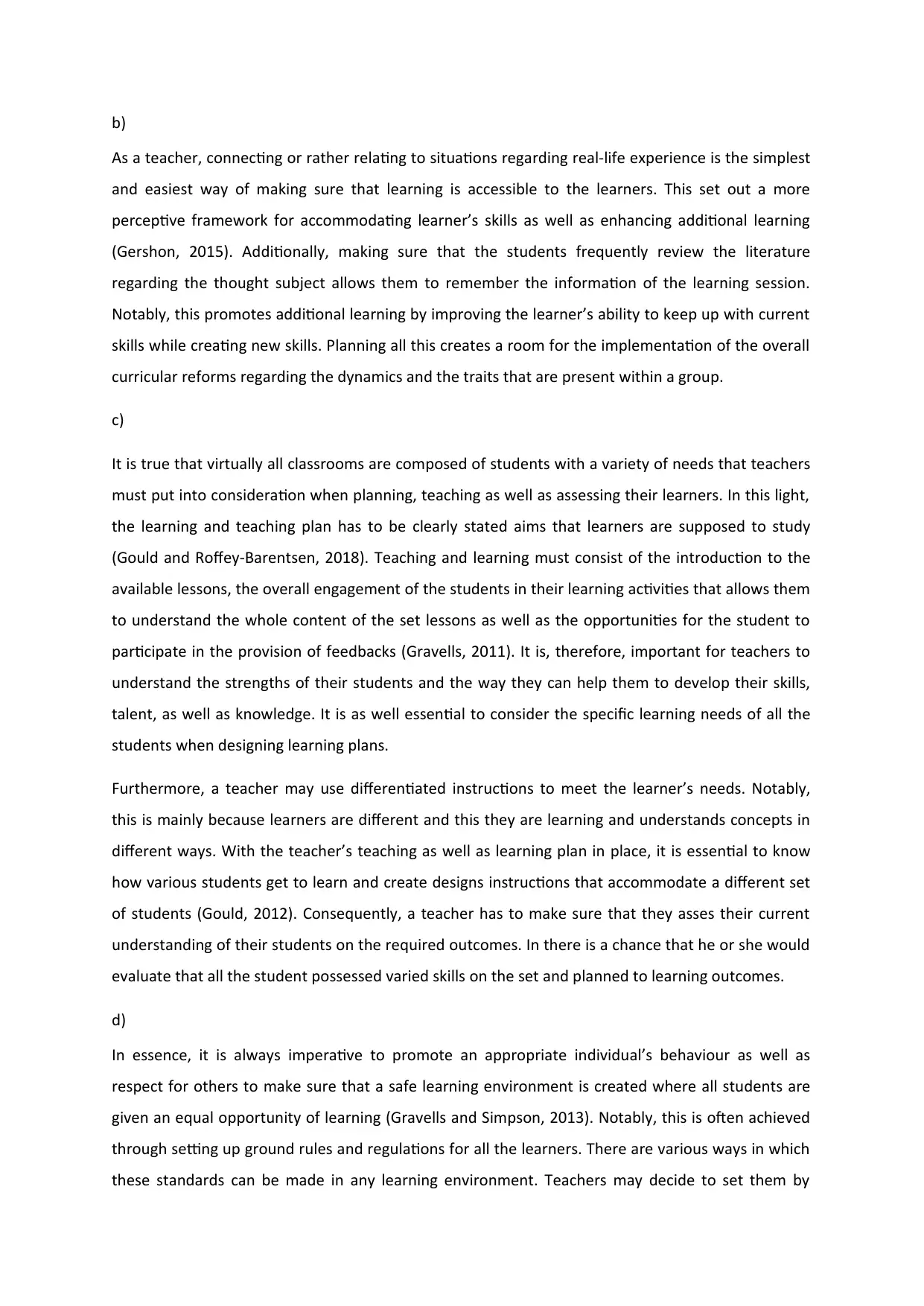
b)
As a teacher, connecting or rather relating to situations regarding real-life experience is the simplest
and easiest way of making sure that learning is accessible to the learners. This set out a more
perceptive framework for accommodating learner’s skills as well as enhancing additional learning
(Gershon, 2015). Additionally, making sure that the students frequently review the literature
regarding the thought subject allows them to remember the information of the learning session.
Notably, this promotes additional learning by improving the learner’s ability to keep up with current
skills while creating new skills. Planning all this creates a room for the implementation of the overall
curricular reforms regarding the dynamics and the traits that are present within a group.
c)
It is true that virtually all classrooms are composed of students with a variety of needs that teachers
must put into consideration when planning, teaching as well as assessing their learners. In this light,
the learning and teaching plan has to be clearly stated aims that learners are supposed to study
(Gould and Roffey-Barentsen, 2018). Teaching and learning must consist of the introduction to the
available lessons, the overall engagement of the students in their learning activities that allows them
to understand the whole content of the set lessons as well as the opportunities for the student to
participate in the provision of feedbacks (Gravells, 2011). It is, therefore, important for teachers to
understand the strengths of their students and the way they can help them to develop their skills,
talent, as well as knowledge. It is as well essential to consider the specific learning needs of all the
students when designing learning plans.
Furthermore, a teacher may use differentiated instructions to meet the learner’s needs. Notably,
this is mainly because learners are different and this they are learning and understands concepts in
different ways. With the teacher’s teaching as well as learning plan in place, it is essential to know
how various students get to learn and create designs instructions that accommodate a different set
of students (Gould, 2012). Consequently, a teacher has to make sure that they asses their current
understanding of their students on the required outcomes. In there is a chance that he or she would
evaluate that all the student possessed varied skills on the set and planned to learning outcomes.
d)
In essence, it is always imperative to promote an appropriate individual’s behaviour as well as
respect for others to make sure that a safe learning environment is created where all students are
given an equal opportunity of learning (Gravells and Simpson, 2013). Notably, this is often achieved
through setting up ground rules and regulations for all the learners. There are various ways in which
these standards can be made in any learning environment. Teachers may decide to set them by
As a teacher, connecting or rather relating to situations regarding real-life experience is the simplest
and easiest way of making sure that learning is accessible to the learners. This set out a more
perceptive framework for accommodating learner’s skills as well as enhancing additional learning
(Gershon, 2015). Additionally, making sure that the students frequently review the literature
regarding the thought subject allows them to remember the information of the learning session.
Notably, this promotes additional learning by improving the learner’s ability to keep up with current
skills while creating new skills. Planning all this creates a room for the implementation of the overall
curricular reforms regarding the dynamics and the traits that are present within a group.
c)
It is true that virtually all classrooms are composed of students with a variety of needs that teachers
must put into consideration when planning, teaching as well as assessing their learners. In this light,
the learning and teaching plan has to be clearly stated aims that learners are supposed to study
(Gould and Roffey-Barentsen, 2018). Teaching and learning must consist of the introduction to the
available lessons, the overall engagement of the students in their learning activities that allows them
to understand the whole content of the set lessons as well as the opportunities for the student to
participate in the provision of feedbacks (Gravells, 2011). It is, therefore, important for teachers to
understand the strengths of their students and the way they can help them to develop their skills,
talent, as well as knowledge. It is as well essential to consider the specific learning needs of all the
students when designing learning plans.
Furthermore, a teacher may use differentiated instructions to meet the learner’s needs. Notably,
this is mainly because learners are different and this they are learning and understands concepts in
different ways. With the teacher’s teaching as well as learning plan in place, it is essential to know
how various students get to learn and create designs instructions that accommodate a different set
of students (Gould, 2012). Consequently, a teacher has to make sure that they asses their current
understanding of their students on the required outcomes. In there is a chance that he or she would
evaluate that all the student possessed varied skills on the set and planned to learning outcomes.
d)
In essence, it is always imperative to promote an appropriate individual’s behaviour as well as
respect for others to make sure that a safe learning environment is created where all students are
given an equal opportunity of learning (Gravells and Simpson, 2013). Notably, this is often achieved
through setting up ground rules and regulations for all the learners. There are various ways in which
these standards can be made in any learning environment. Teachers may decide to set them by
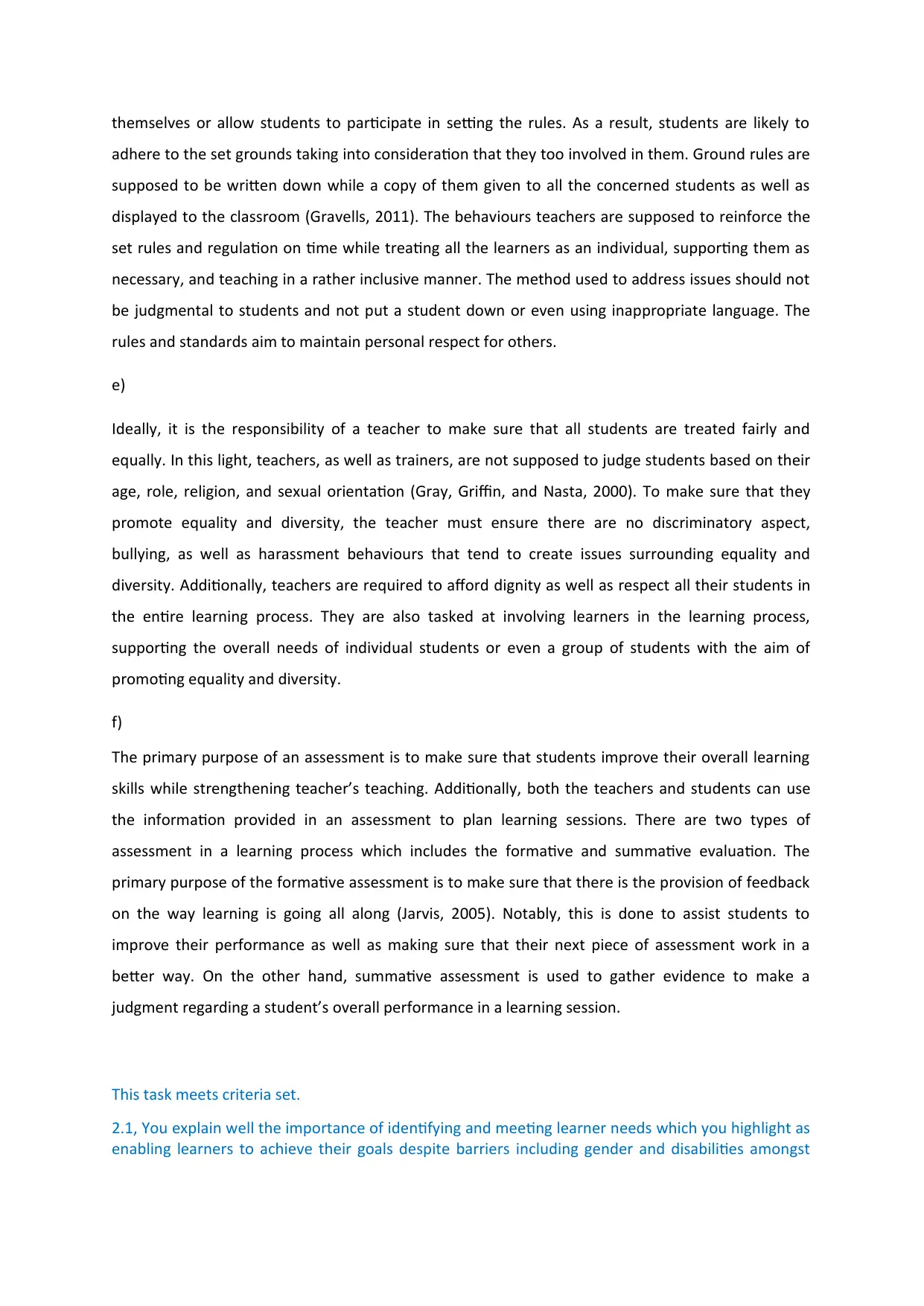
themselves or allow students to participate in setting the rules. As a result, students are likely to
adhere to the set grounds taking into consideration that they too involved in them. Ground rules are
supposed to be written down while a copy of them given to all the concerned students as well as
displayed to the classroom (Gravells, 2011). The behaviours teachers are supposed to reinforce the
set rules and regulation on time while treating all the learners as an individual, supporting them as
necessary, and teaching in a rather inclusive manner. The method used to address issues should not
be judgmental to students and not put a student down or even using inappropriate language. The
rules and standards aim to maintain personal respect for others.
e)
Ideally, it is the responsibility of a teacher to make sure that all students are treated fairly and
equally. In this light, teachers, as well as trainers, are not supposed to judge students based on their
age, role, religion, and sexual orientation (Gray, Griffin, and Nasta, 2000). To make sure that they
promote equality and diversity, the teacher must ensure there are no discriminatory aspect,
bullying, as well as harassment behaviours that tend to create issues surrounding equality and
diversity. Additionally, teachers are required to afford dignity as well as respect all their students in
the entire learning process. They are also tasked at involving learners in the learning process,
supporting the overall needs of individual students or even a group of students with the aim of
promoting equality and diversity.
f)
The primary purpose of an assessment is to make sure that students improve their overall learning
skills while strengthening teacher’s teaching. Additionally, both the teachers and students can use
the information provided in an assessment to plan learning sessions. There are two types of
assessment in a learning process which includes the formative and summative evaluation. The
primary purpose of the formative assessment is to make sure that there is the provision of feedback
on the way learning is going all along (Jarvis, 2005). Notably, this is done to assist students to
improve their performance as well as making sure that their next piece of assessment work in a
better way. On the other hand, summative assessment is used to gather evidence to make a
judgment regarding a student’s overall performance in a learning session.
This task meets criteria set.
2.1, You explain well the importance of identifying and meeting learner needs which you highlight as
enabling learners to achieve their goals despite barriers including gender and disabilities amongst
adhere to the set grounds taking into consideration that they too involved in them. Ground rules are
supposed to be written down while a copy of them given to all the concerned students as well as
displayed to the classroom (Gravells, 2011). The behaviours teachers are supposed to reinforce the
set rules and regulation on time while treating all the learners as an individual, supporting them as
necessary, and teaching in a rather inclusive manner. The method used to address issues should not
be judgmental to students and not put a student down or even using inappropriate language. The
rules and standards aim to maintain personal respect for others.
e)
Ideally, it is the responsibility of a teacher to make sure that all students are treated fairly and
equally. In this light, teachers, as well as trainers, are not supposed to judge students based on their
age, role, religion, and sexual orientation (Gray, Griffin, and Nasta, 2000). To make sure that they
promote equality and diversity, the teacher must ensure there are no discriminatory aspect,
bullying, as well as harassment behaviours that tend to create issues surrounding equality and
diversity. Additionally, teachers are required to afford dignity as well as respect all their students in
the entire learning process. They are also tasked at involving learners in the learning process,
supporting the overall needs of individual students or even a group of students with the aim of
promoting equality and diversity.
f)
The primary purpose of an assessment is to make sure that students improve their overall learning
skills while strengthening teacher’s teaching. Additionally, both the teachers and students can use
the information provided in an assessment to plan learning sessions. There are two types of
assessment in a learning process which includes the formative and summative evaluation. The
primary purpose of the formative assessment is to make sure that there is the provision of feedback
on the way learning is going all along (Jarvis, 2005). Notably, this is done to assist students to
improve their performance as well as making sure that their next piece of assessment work in a
better way. On the other hand, summative assessment is used to gather evidence to make a
judgment regarding a student’s overall performance in a learning session.
This task meets criteria set.
2.1, You explain well the importance of identifying and meeting learner needs which you highlight as
enabling learners to achieve their goals despite barriers including gender and disabilities amongst
Paraphrase This Document
Need a fresh take? Get an instant paraphrase of this document with our AI Paraphraser
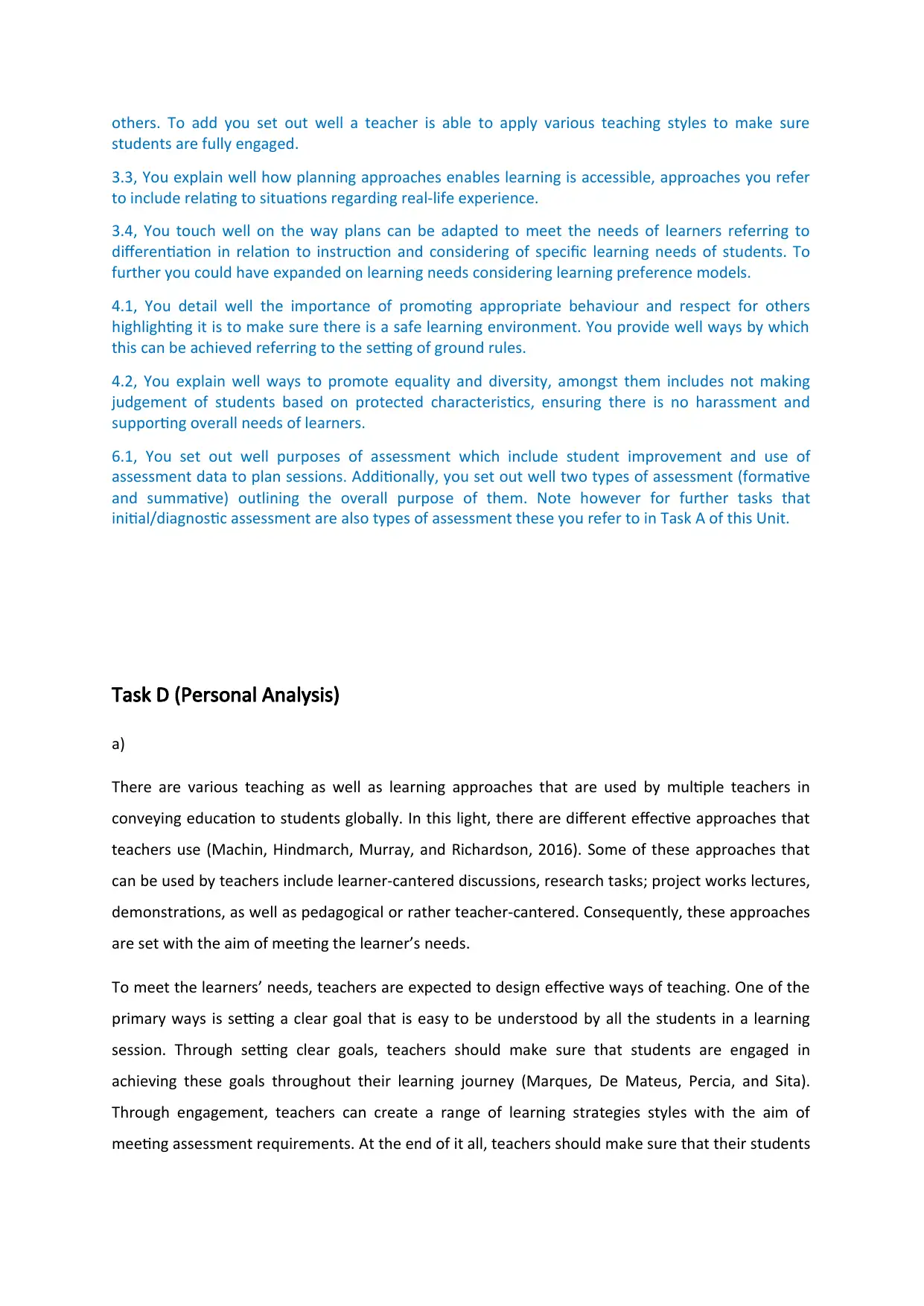
others. To add you set out well a teacher is able to apply various teaching styles to make sure
students are fully engaged.
3.3, You explain well how planning approaches enables learning is accessible, approaches you refer
to include relating to situations regarding real-life experience.
3.4, You touch well on the way plans can be adapted to meet the needs of learners referring to
differentiation in relation to instruction and considering of specific learning needs of students. To
further you could have expanded on learning needs considering learning preference models.
4.1, You detail well the importance of promoting appropriate behaviour and respect for others
highlighting it is to make sure there is a safe learning environment. You provide well ways by which
this can be achieved referring to the setting of ground rules.
4.2, You explain well ways to promote equality and diversity, amongst them includes not making
judgement of students based on protected characteristics, ensuring there is no harassment and
supporting overall needs of learners.
6.1, You set out well purposes of assessment which include student improvement and use of
assessment data to plan sessions. Additionally, you set out well two types of assessment (formative
and summative) outlining the overall purpose of them. Note however for further tasks that
initial/diagnostic assessment are also types of assessment these you refer to in Task A of this Unit.
Task D (Personal Analysis)
a)
There are various teaching as well as learning approaches that are used by multiple teachers in
conveying education to students globally. In this light, there are different effective approaches that
teachers use (Machin, Hindmarch, Murray, and Richardson, 2016). Some of these approaches that
can be used by teachers include learner-cantered discussions, research tasks; project works lectures,
demonstrations, as well as pedagogical or rather teacher-cantered. Consequently, these approaches
are set with the aim of meeting the learner’s needs.
To meet the learners’ needs, teachers are expected to design effective ways of teaching. One of the
primary ways is setting a clear goal that is easy to be understood by all the students in a learning
session. Through setting clear goals, teachers should make sure that students are engaged in
achieving these goals throughout their learning journey (Marques, De Mateus, Percia, and Sita).
Through engagement, teachers can create a range of learning strategies styles with the aim of
meeting assessment requirements. At the end of it all, teachers should make sure that their students
students are fully engaged.
3.3, You explain well how planning approaches enables learning is accessible, approaches you refer
to include relating to situations regarding real-life experience.
3.4, You touch well on the way plans can be adapted to meet the needs of learners referring to
differentiation in relation to instruction and considering of specific learning needs of students. To
further you could have expanded on learning needs considering learning preference models.
4.1, You detail well the importance of promoting appropriate behaviour and respect for others
highlighting it is to make sure there is a safe learning environment. You provide well ways by which
this can be achieved referring to the setting of ground rules.
4.2, You explain well ways to promote equality and diversity, amongst them includes not making
judgement of students based on protected characteristics, ensuring there is no harassment and
supporting overall needs of learners.
6.1, You set out well purposes of assessment which include student improvement and use of
assessment data to plan sessions. Additionally, you set out well two types of assessment (formative
and summative) outlining the overall purpose of them. Note however for further tasks that
initial/diagnostic assessment are also types of assessment these you refer to in Task A of this Unit.
Task D (Personal Analysis)
a)
There are various teaching as well as learning approaches that are used by multiple teachers in
conveying education to students globally. In this light, there are different effective approaches that
teachers use (Machin, Hindmarch, Murray, and Richardson, 2016). Some of these approaches that
can be used by teachers include learner-cantered discussions, research tasks; project works lectures,
demonstrations, as well as pedagogical or rather teacher-cantered. Consequently, these approaches
are set with the aim of meeting the learner’s needs.
To meet the learners’ needs, teachers are expected to design effective ways of teaching. One of the
primary ways is setting a clear goal that is easy to be understood by all the students in a learning
session. Through setting clear goals, teachers should make sure that students are engaged in
achieving these goals throughout their learning journey (Marques, De Mateus, Percia, and Sita).
Through engagement, teachers can create a range of learning strategies styles with the aim of
meeting assessment requirements. At the end of it all, teachers should make sure that their students
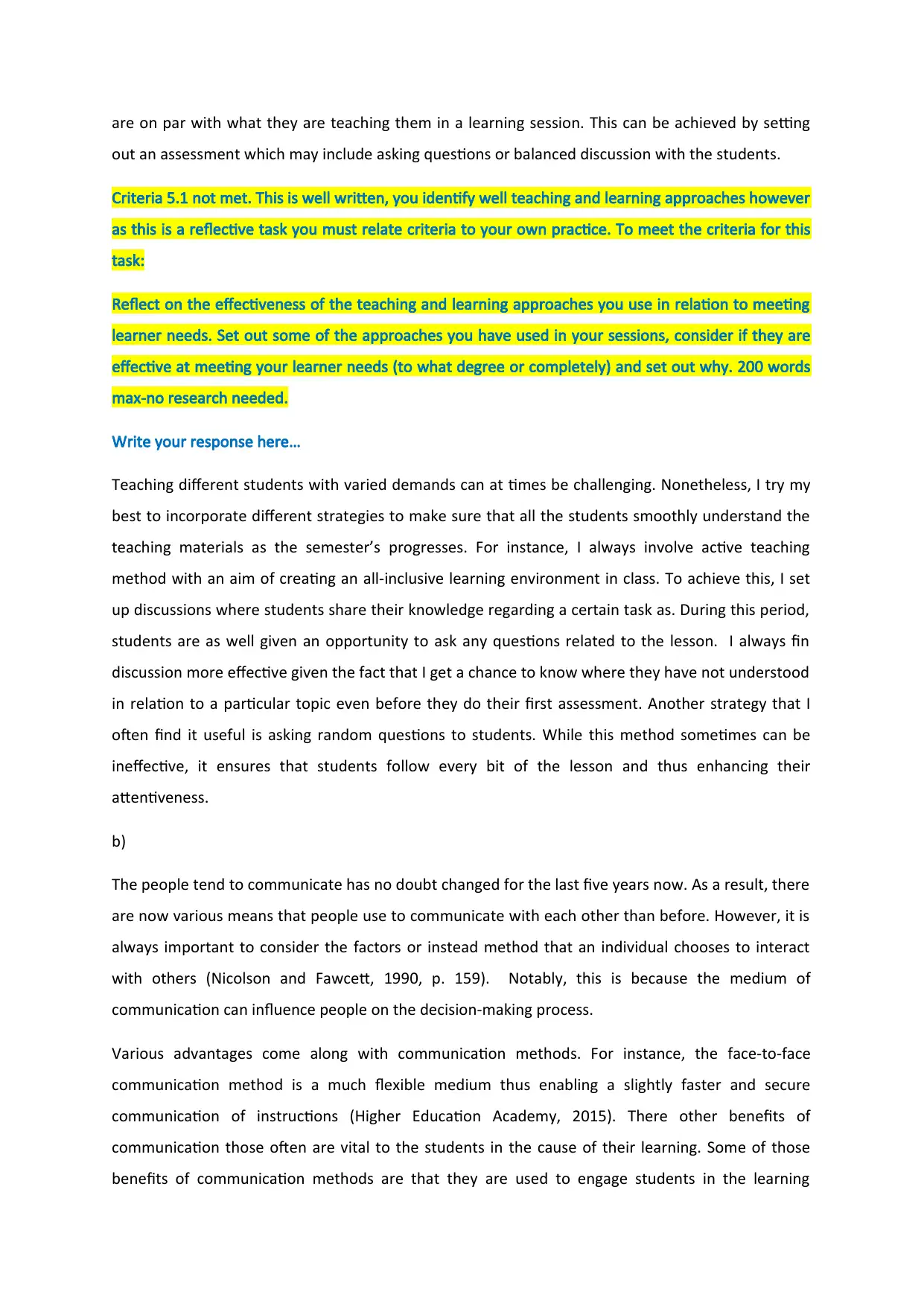
are on par with what they are teaching them in a learning session. This can be achieved by setting
out an assessment which may include asking questions or balanced discussion with the students.
Criteria 5.1 not met. This is well written, you identify well teaching and learning approaches however
as this is a reflective task you must relate criteria to your own practice. To meet the criteria for this
task:
Reflect on the effectiveness of the teaching and learning approaches you use in relation to meeting
learner needs. Set out some of the approaches you have used in your sessions, consider if they are
effective at meeting your learner needs (to what degree or completely) and set out why. 200 words
max-no research needed.
Write your response here…
Teaching different students with varied demands can at times be challenging. Nonetheless, I try my
best to incorporate different strategies to make sure that all the students smoothly understand the
teaching materials as the semester’s progresses. For instance, I always involve active teaching
method with an aim of creating an all-inclusive learning environment in class. To achieve this, I set
up discussions where students share their knowledge regarding a certain task as. During this period,
students are as well given an opportunity to ask any questions related to the lesson. I always fin
discussion more effective given the fact that I get a chance to know where they have not understood
in relation to a particular topic even before they do their first assessment. Another strategy that I
often find it useful is asking random questions to students. While this method sometimes can be
ineffective, it ensures that students follow every bit of the lesson and thus enhancing their
attentiveness.
b)
The people tend to communicate has no doubt changed for the last five years now. As a result, there
are now various means that people use to communicate with each other than before. However, it is
always important to consider the factors or instead method that an individual chooses to interact
with others (Nicolson and Fawcett, 1990, p. 159). Notably, this is because the medium of
communication can influence people on the decision-making process.
Various advantages come along with communication methods. For instance, the face-to-face
communication method is a much flexible medium thus enabling a slightly faster and secure
communication of instructions (Higher Education Academy, 2015). There other benefits of
communication those often are vital to the students in the cause of their learning. Some of those
benefits of communication methods are that they are used to engage students in the learning
out an assessment which may include asking questions or balanced discussion with the students.
Criteria 5.1 not met. This is well written, you identify well teaching and learning approaches however
as this is a reflective task you must relate criteria to your own practice. To meet the criteria for this
task:
Reflect on the effectiveness of the teaching and learning approaches you use in relation to meeting
learner needs. Set out some of the approaches you have used in your sessions, consider if they are
effective at meeting your learner needs (to what degree or completely) and set out why. 200 words
max-no research needed.
Write your response here…
Teaching different students with varied demands can at times be challenging. Nonetheless, I try my
best to incorporate different strategies to make sure that all the students smoothly understand the
teaching materials as the semester’s progresses. For instance, I always involve active teaching
method with an aim of creating an all-inclusive learning environment in class. To achieve this, I set
up discussions where students share their knowledge regarding a certain task as. During this period,
students are as well given an opportunity to ask any questions related to the lesson. I always fin
discussion more effective given the fact that I get a chance to know where they have not understood
in relation to a particular topic even before they do their first assessment. Another strategy that I
often find it useful is asking random questions to students. While this method sometimes can be
ineffective, it ensures that students follow every bit of the lesson and thus enhancing their
attentiveness.
b)
The people tend to communicate has no doubt changed for the last five years now. As a result, there
are now various means that people use to communicate with each other than before. However, it is
always important to consider the factors or instead method that an individual chooses to interact
with others (Nicolson and Fawcett, 1990, p. 159). Notably, this is because the medium of
communication can influence people on the decision-making process.
Various advantages come along with communication methods. For instance, the face-to-face
communication method is a much flexible medium thus enabling a slightly faster and secure
communication of instructions (Higher Education Academy, 2015). There other benefits of
communication those often are vital to the students in the cause of their learning. Some of those
benefits of communication methods are that they are used to engage students in the learning
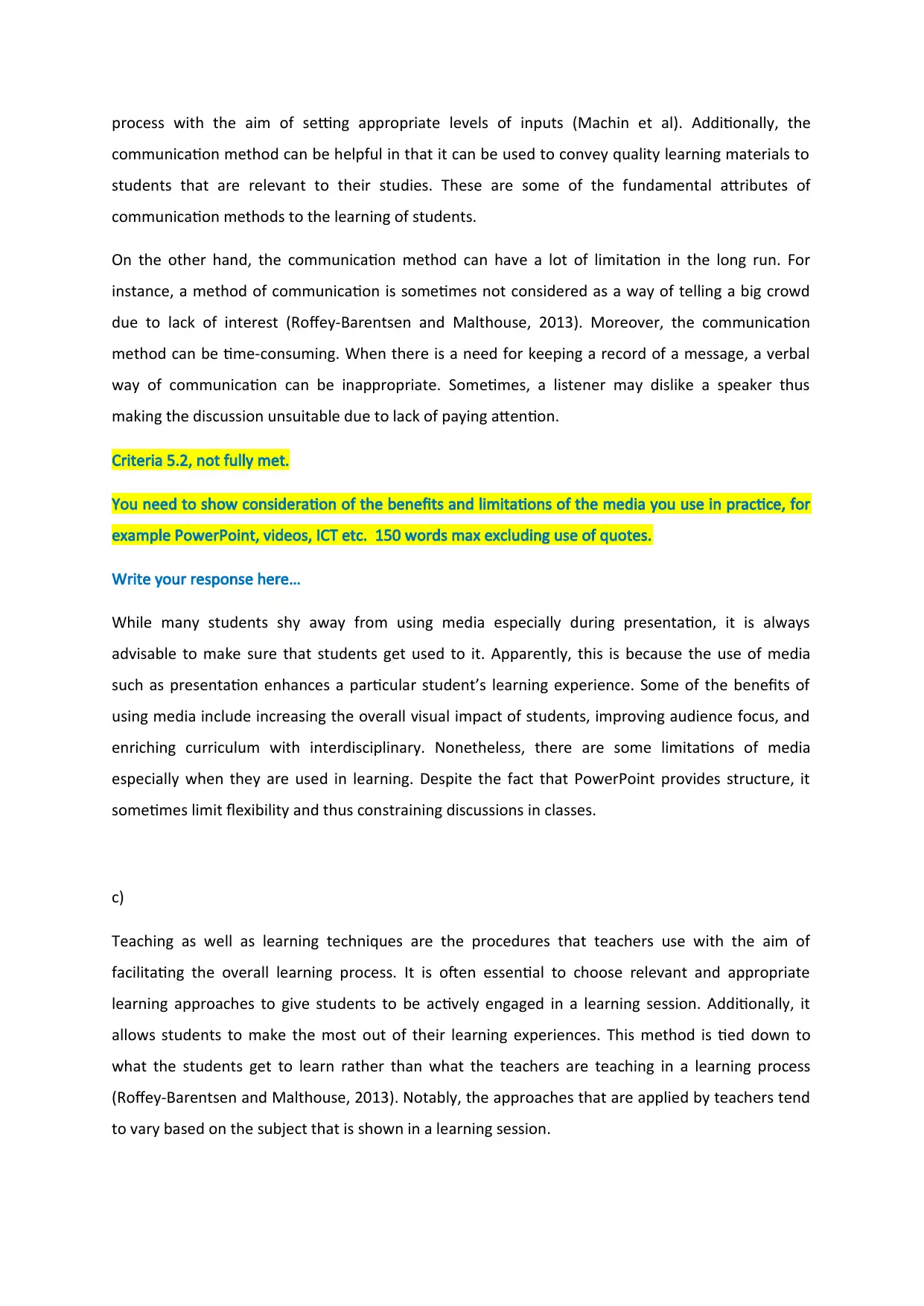
process with the aim of setting appropriate levels of inputs (Machin et al). Additionally, the
communication method can be helpful in that it can be used to convey quality learning materials to
students that are relevant to their studies. These are some of the fundamental attributes of
communication methods to the learning of students.
On the other hand, the communication method can have a lot of limitation in the long run. For
instance, a method of communication is sometimes not considered as a way of telling a big crowd
due to lack of interest (Roffey-Barentsen and Malthouse, 2013). Moreover, the communication
method can be time-consuming. When there is a need for keeping a record of a message, a verbal
way of communication can be inappropriate. Sometimes, a listener may dislike a speaker thus
making the discussion unsuitable due to lack of paying attention.
Criteria 5.2, not fully met.
You need to show consideration of the benefits and limitations of the media you use in practice, for
example PowerPoint, videos, ICT etc. 150 words max excluding use of quotes.
Write your response here…
While many students shy away from using media especially during presentation, it is always
advisable to make sure that students get used to it. Apparently, this is because the use of media
such as presentation enhances a particular student’s learning experience. Some of the benefits of
using media include increasing the overall visual impact of students, improving audience focus, and
enriching curriculum with interdisciplinary. Nonetheless, there are some limitations of media
especially when they are used in learning. Despite the fact that PowerPoint provides structure, it
sometimes limit flexibility and thus constraining discussions in classes.
c)
Teaching as well as learning techniques are the procedures that teachers use with the aim of
facilitating the overall learning process. It is often essential to choose relevant and appropriate
learning approaches to give students to be actively engaged in a learning session. Additionally, it
allows students to make the most out of their learning experiences. This method is tied down to
what the students get to learn rather than what the teachers are teaching in a learning process
(Roffey-Barentsen and Malthouse, 2013). Notably, the approaches that are applied by teachers tend
to vary based on the subject that is shown in a learning session.
communication method can be helpful in that it can be used to convey quality learning materials to
students that are relevant to their studies. These are some of the fundamental attributes of
communication methods to the learning of students.
On the other hand, the communication method can have a lot of limitation in the long run. For
instance, a method of communication is sometimes not considered as a way of telling a big crowd
due to lack of interest (Roffey-Barentsen and Malthouse, 2013). Moreover, the communication
method can be time-consuming. When there is a need for keeping a record of a message, a verbal
way of communication can be inappropriate. Sometimes, a listener may dislike a speaker thus
making the discussion unsuitable due to lack of paying attention.
Criteria 5.2, not fully met.
You need to show consideration of the benefits and limitations of the media you use in practice, for
example PowerPoint, videos, ICT etc. 150 words max excluding use of quotes.
Write your response here…
While many students shy away from using media especially during presentation, it is always
advisable to make sure that students get used to it. Apparently, this is because the use of media
such as presentation enhances a particular student’s learning experience. Some of the benefits of
using media include increasing the overall visual impact of students, improving audience focus, and
enriching curriculum with interdisciplinary. Nonetheless, there are some limitations of media
especially when they are used in learning. Despite the fact that PowerPoint provides structure, it
sometimes limit flexibility and thus constraining discussions in classes.
c)
Teaching as well as learning techniques are the procedures that teachers use with the aim of
facilitating the overall learning process. It is often essential to choose relevant and appropriate
learning approaches to give students to be actively engaged in a learning session. Additionally, it
allows students to make the most out of their learning experiences. This method is tied down to
what the students get to learn rather than what the teachers are teaching in a learning process
(Roffey-Barentsen and Malthouse, 2013). Notably, the approaches that are applied by teachers tend
to vary based on the subject that is shown in a learning session.
Secure Best Marks with AI Grader
Need help grading? Try our AI Grader for instant feedback on your assignments.
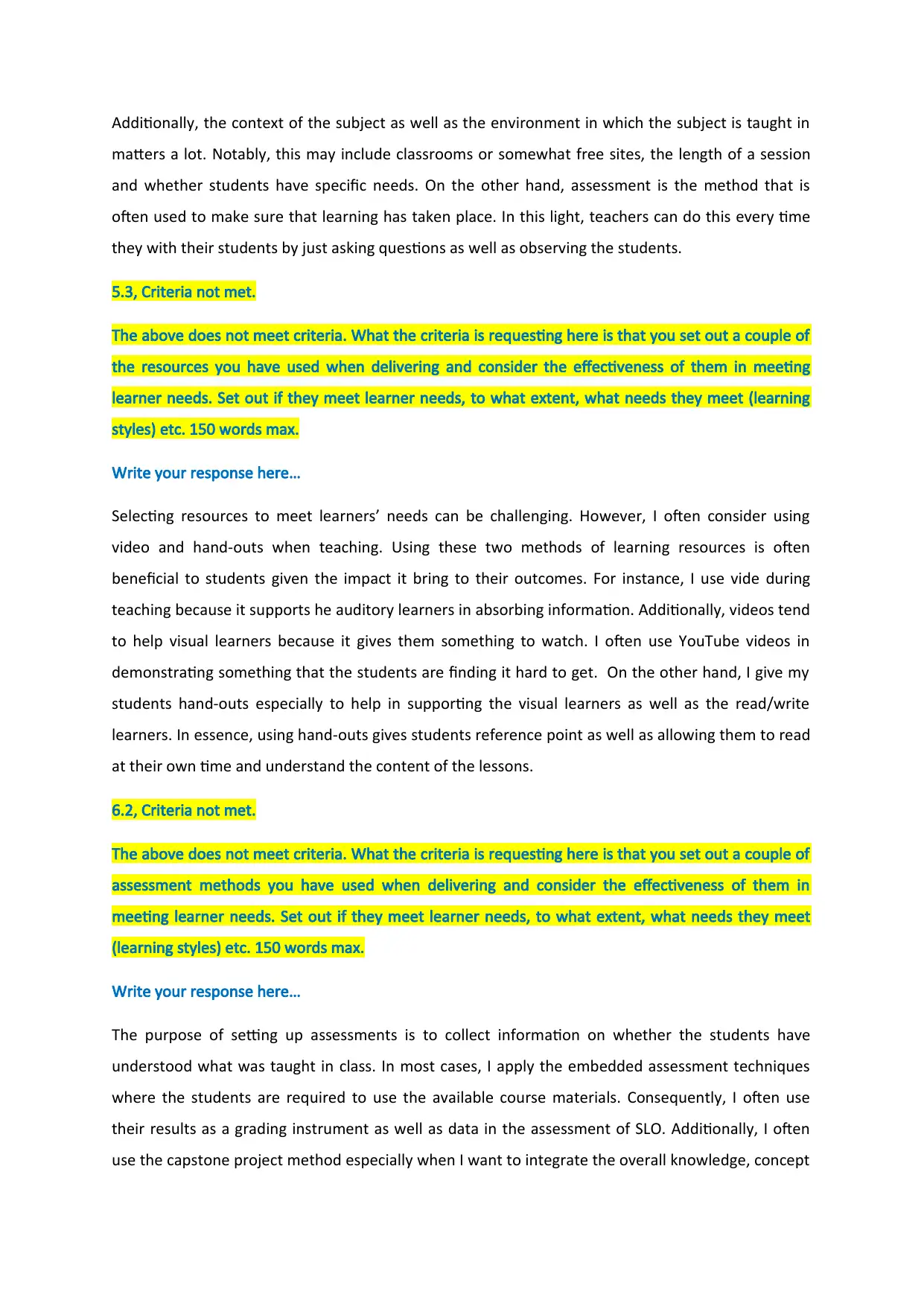
Additionally, the context of the subject as well as the environment in which the subject is taught in
matters a lot. Notably, this may include classrooms or somewhat free sites, the length of a session
and whether students have specific needs. On the other hand, assessment is the method that is
often used to make sure that learning has taken place. In this light, teachers can do this every time
they with their students by just asking questions as well as observing the students.
5.3, Criteria not met.
The above does not meet criteria. What the criteria is requesting here is that you set out a couple of
the resources you have used when delivering and consider the effectiveness of them in meeting
learner needs. Set out if they meet learner needs, to what extent, what needs they meet (learning
styles) etc. 150 words max.
Write your response here…
Selecting resources to meet learners’ needs can be challenging. However, I often consider using
video and hand-outs when teaching. Using these two methods of learning resources is often
beneficial to students given the impact it bring to their outcomes. For instance, I use vide during
teaching because it supports he auditory learners in absorbing information. Additionally, videos tend
to help visual learners because it gives them something to watch. I often use YouTube videos in
demonstrating something that the students are finding it hard to get. On the other hand, I give my
students hand-outs especially to help in supporting the visual learners as well as the read/write
learners. In essence, using hand-outs gives students reference point as well as allowing them to read
at their own time and understand the content of the lessons.
6.2, Criteria not met.
The above does not meet criteria. What the criteria is requesting here is that you set out a couple of
assessment methods you have used when delivering and consider the effectiveness of them in
meeting learner needs. Set out if they meet learner needs, to what extent, what needs they meet
(learning styles) etc. 150 words max.
Write your response here…
The purpose of setting up assessments is to collect information on whether the students have
understood what was taught in class. In most cases, I apply the embedded assessment techniques
where the students are required to use the available course materials. Consequently, I often use
their results as a grading instrument as well as data in the assessment of SLO. Additionally, I often
use the capstone project method especially when I want to integrate the overall knowledge, concept
matters a lot. Notably, this may include classrooms or somewhat free sites, the length of a session
and whether students have specific needs. On the other hand, assessment is the method that is
often used to make sure that learning has taken place. In this light, teachers can do this every time
they with their students by just asking questions as well as observing the students.
5.3, Criteria not met.
The above does not meet criteria. What the criteria is requesting here is that you set out a couple of
the resources you have used when delivering and consider the effectiveness of them in meeting
learner needs. Set out if they meet learner needs, to what extent, what needs they meet (learning
styles) etc. 150 words max.
Write your response here…
Selecting resources to meet learners’ needs can be challenging. However, I often consider using
video and hand-outs when teaching. Using these two methods of learning resources is often
beneficial to students given the impact it bring to their outcomes. For instance, I use vide during
teaching because it supports he auditory learners in absorbing information. Additionally, videos tend
to help visual learners because it gives them something to watch. I often use YouTube videos in
demonstrating something that the students are finding it hard to get. On the other hand, I give my
students hand-outs especially to help in supporting the visual learners as well as the read/write
learners. In essence, using hand-outs gives students reference point as well as allowing them to read
at their own time and understand the content of the lessons.
6.2, Criteria not met.
The above does not meet criteria. What the criteria is requesting here is that you set out a couple of
assessment methods you have used when delivering and consider the effectiveness of them in
meeting learner needs. Set out if they meet learner needs, to what extent, what needs they meet
(learning styles) etc. 150 words max.
Write your response here…
The purpose of setting up assessments is to collect information on whether the students have
understood what was taught in class. In most cases, I apply the embedded assessment techniques
where the students are required to use the available course materials. Consequently, I often use
their results as a grading instrument as well as data in the assessment of SLO. Additionally, I often
use the capstone project method especially when I want to integrate the overall knowledge, concept
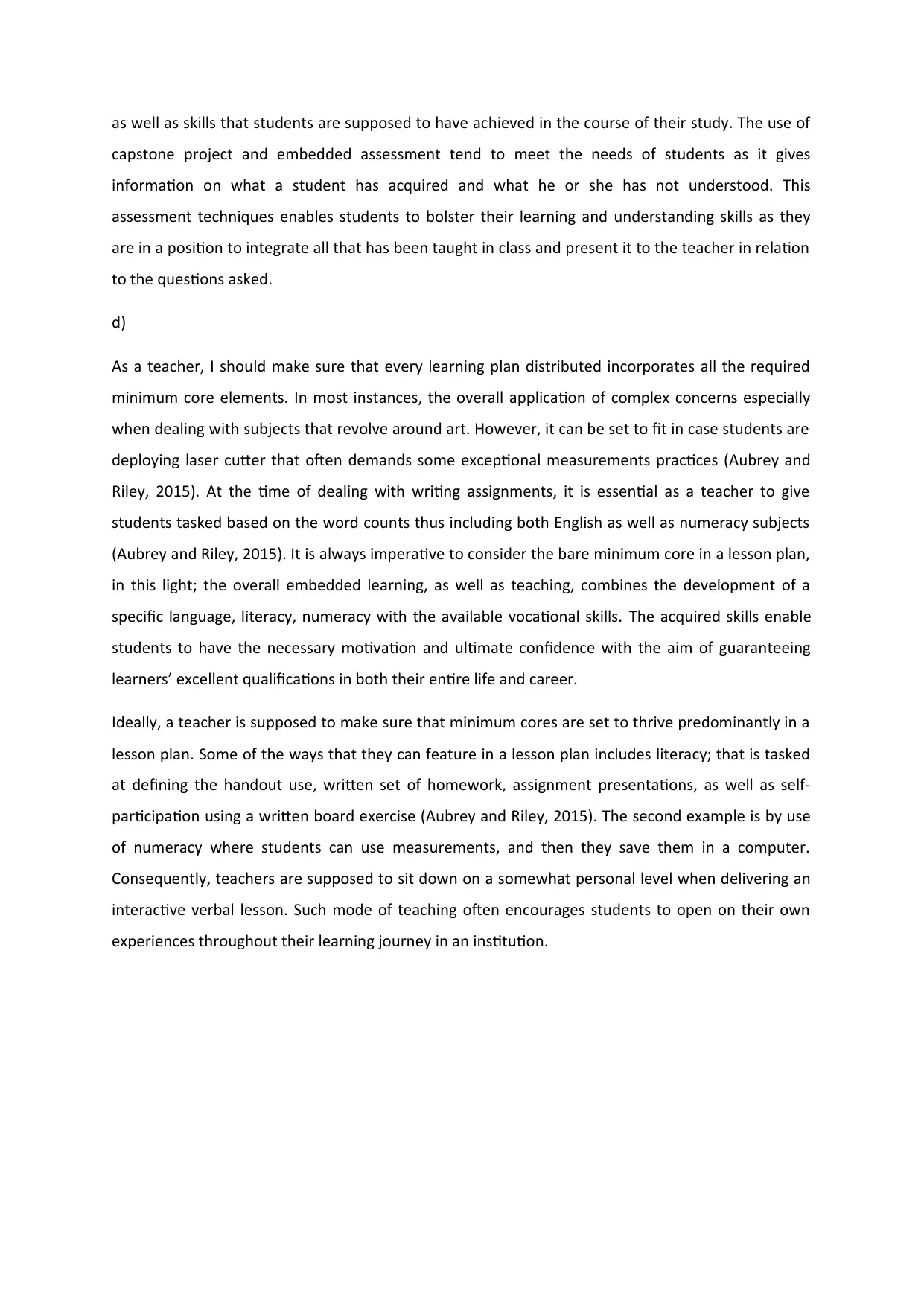
as well as skills that students are supposed to have achieved in the course of their study. The use of
capstone project and embedded assessment tend to meet the needs of students as it gives
information on what a student has acquired and what he or she has not understood. This
assessment techniques enables students to bolster their learning and understanding skills as they
are in a position to integrate all that has been taught in class and present it to the teacher in relation
to the questions asked.
d)
As a teacher, I should make sure that every learning plan distributed incorporates all the required
minimum core elements. In most instances, the overall application of complex concerns especially
when dealing with subjects that revolve around art. However, it can be set to fit in case students are
deploying laser cutter that often demands some exceptional measurements practices (Aubrey and
Riley, 2015). At the time of dealing with writing assignments, it is essential as a teacher to give
students tasked based on the word counts thus including both English as well as numeracy subjects
(Aubrey and Riley, 2015). It is always imperative to consider the bare minimum core in a lesson plan,
in this light; the overall embedded learning, as well as teaching, combines the development of a
specific language, literacy, numeracy with the available vocational skills. The acquired skills enable
students to have the necessary motivation and ultimate confidence with the aim of guaranteeing
learners’ excellent qualifications in both their entire life and career.
Ideally, a teacher is supposed to make sure that minimum cores are set to thrive predominantly in a
lesson plan. Some of the ways that they can feature in a lesson plan includes literacy; that is tasked
at defining the handout use, written set of homework, assignment presentations, as well as self-
participation using a written board exercise (Aubrey and Riley, 2015). The second example is by use
of numeracy where students can use measurements, and then they save them in a computer.
Consequently, teachers are supposed to sit down on a somewhat personal level when delivering an
interactive verbal lesson. Such mode of teaching often encourages students to open on their own
experiences throughout their learning journey in an institution.
capstone project and embedded assessment tend to meet the needs of students as it gives
information on what a student has acquired and what he or she has not understood. This
assessment techniques enables students to bolster their learning and understanding skills as they
are in a position to integrate all that has been taught in class and present it to the teacher in relation
to the questions asked.
d)
As a teacher, I should make sure that every learning plan distributed incorporates all the required
minimum core elements. In most instances, the overall application of complex concerns especially
when dealing with subjects that revolve around art. However, it can be set to fit in case students are
deploying laser cutter that often demands some exceptional measurements practices (Aubrey and
Riley, 2015). At the time of dealing with writing assignments, it is essential as a teacher to give
students tasked based on the word counts thus including both English as well as numeracy subjects
(Aubrey and Riley, 2015). It is always imperative to consider the bare minimum core in a lesson plan,
in this light; the overall embedded learning, as well as teaching, combines the development of a
specific language, literacy, numeracy with the available vocational skills. The acquired skills enable
students to have the necessary motivation and ultimate confidence with the aim of guaranteeing
learners’ excellent qualifications in both their entire life and career.
Ideally, a teacher is supposed to make sure that minimum cores are set to thrive predominantly in a
lesson plan. Some of the ways that they can feature in a lesson plan includes literacy; that is tasked
at defining the handout use, written set of homework, assignment presentations, as well as self-
participation using a written board exercise (Aubrey and Riley, 2015). The second example is by use
of numeracy where students can use measurements, and then they save them in a computer.
Consequently, teachers are supposed to sit down on a somewhat personal level when delivering an
interactive verbal lesson. Such mode of teaching often encourages students to open on their own
experiences throughout their learning journey in an institution.
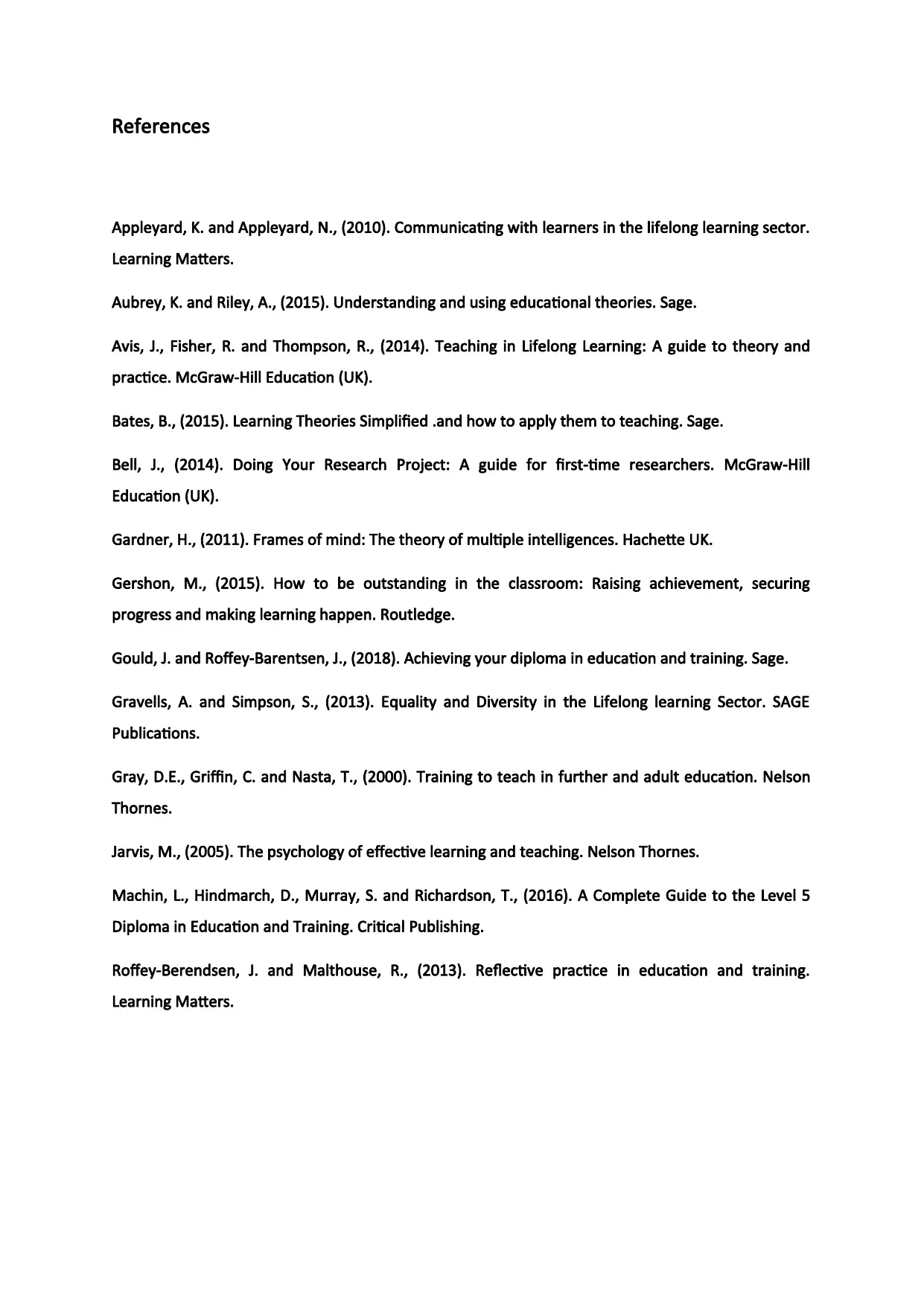
References
Appleyard, K. and Appleyard, N., (2010). Communicating with learners in the lifelong learning sector.
Learning Matters.
Aubrey, K. and Riley, A., (2015). Understanding and using educational theories. Sage.
Avis, J., Fisher, R. and Thompson, R., (2014). Teaching in Lifelong Learning: A guide to theory and
practice. McGraw-Hill Education (UK).
Bates, B., (2015). Learning Theories Simplified .and how to apply them to teaching. Sage.
Bell, J., (2014). Doing Your Research Project: A guide for first-time researchers. McGraw-Hill
Education (UK).
Gardner, H., (2011). Frames of mind: The theory of multiple intelligences. Hachette UK.
Gershon, M., (2015). How to be outstanding in the classroom: Raising achievement, securing
progress and making learning happen. Routledge.
Gould, J. and Roffey-Barentsen, J., (2018). Achieving your diploma in education and training. Sage.
Gravells, A. and Simpson, S., (2013). Equality and Diversity in the Lifelong learning Sector. SAGE
Publications.
Gray, D.E., Griffin, C. and Nasta, T., (2000). Training to teach in further and adult education. Nelson
Thornes.
Jarvis, M., (2005). The psychology of effective learning and teaching. Nelson Thornes.
Machin, L., Hindmarch, D., Murray, S. and Richardson, T., (2016). A Complete Guide to the Level 5
Diploma in Education and Training. Critical Publishing.
Roffey-Berendsen, J. and Malthouse, R., (2013). Reflective practice in education and training.
Learning Matters.
Appleyard, K. and Appleyard, N., (2010). Communicating with learners in the lifelong learning sector.
Learning Matters.
Aubrey, K. and Riley, A., (2015). Understanding and using educational theories. Sage.
Avis, J., Fisher, R. and Thompson, R., (2014). Teaching in Lifelong Learning: A guide to theory and
practice. McGraw-Hill Education (UK).
Bates, B., (2015). Learning Theories Simplified .and how to apply them to teaching. Sage.
Bell, J., (2014). Doing Your Research Project: A guide for first-time researchers. McGraw-Hill
Education (UK).
Gardner, H., (2011). Frames of mind: The theory of multiple intelligences. Hachette UK.
Gershon, M., (2015). How to be outstanding in the classroom: Raising achievement, securing
progress and making learning happen. Routledge.
Gould, J. and Roffey-Barentsen, J., (2018). Achieving your diploma in education and training. Sage.
Gravells, A. and Simpson, S., (2013). Equality and Diversity in the Lifelong learning Sector. SAGE
Publications.
Gray, D.E., Griffin, C. and Nasta, T., (2000). Training to teach in further and adult education. Nelson
Thornes.
Jarvis, M., (2005). The psychology of effective learning and teaching. Nelson Thornes.
Machin, L., Hindmarch, D., Murray, S. and Richardson, T., (2016). A Complete Guide to the Level 5
Diploma in Education and Training. Critical Publishing.
Roffey-Berendsen, J. and Malthouse, R., (2013). Reflective practice in education and training.
Learning Matters.
1 out of 13
Related Documents
Your All-in-One AI-Powered Toolkit for Academic Success.
+13062052269
info@desklib.com
Available 24*7 on WhatsApp / Email
![[object Object]](/_next/static/media/star-bottom.7253800d.svg)
Unlock your academic potential
© 2024 | Zucol Services PVT LTD | All rights reserved.




